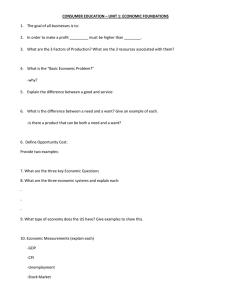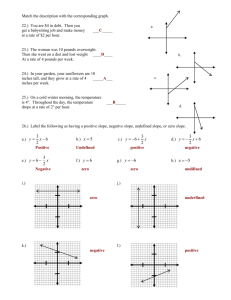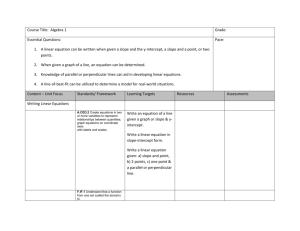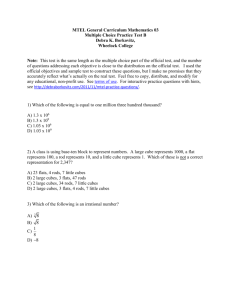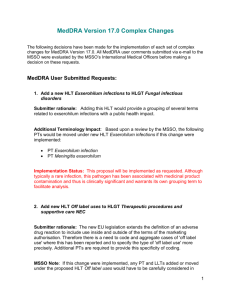Unit A - MentorMob
advertisement
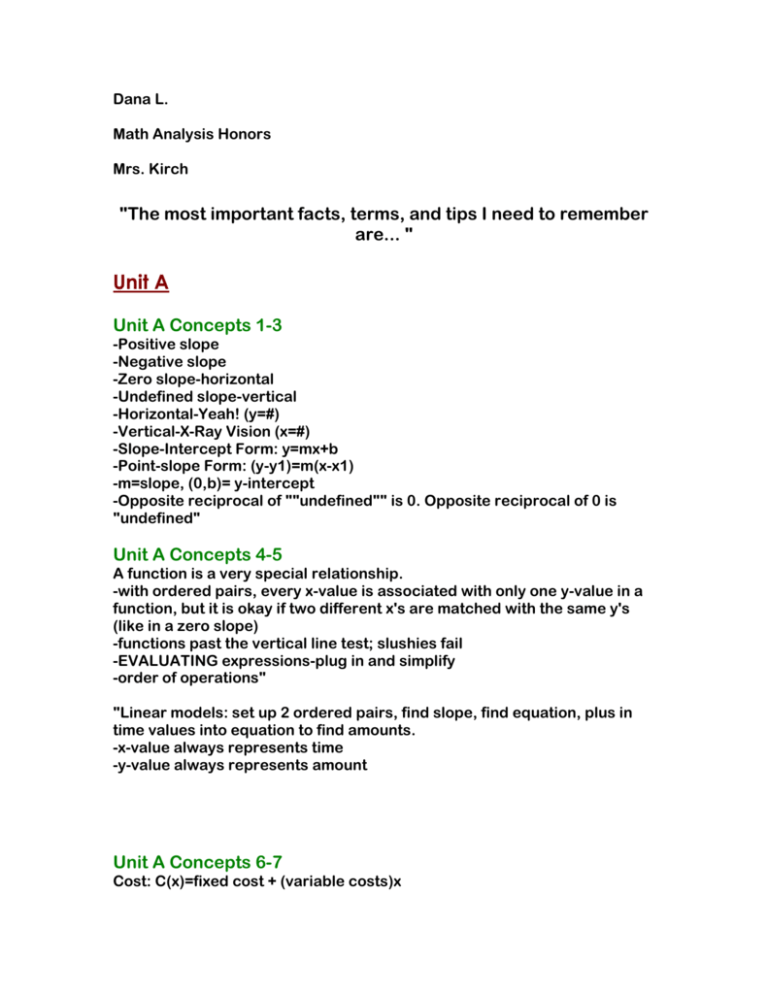
Dana L. Math Analysis Honors Mrs. Kirch "The most important facts, terms, and tips I need to remember are... " Unit A Unit A Concepts 1-3 -Positive slope -Negative slope -Zero slope-horizontal -Undefined slope-vertical -Horizontal-Yeah! (y=#) -Vertical-X-Ray Vision (x=#) -Slope-Intercept Form: y=mx+b -Point-slope Form: (y-y1)=m(x-x1) -m=slope, (0,b)= y-intercept -Opposite reciprocal of ""undefined"" is 0. Opposite reciprocal of 0 is "undefined" Unit A Concepts 4-5 A function is a very special relationship. -with ordered pairs, every x-value is associated with only one y-value in a function, but it is okay if two different x's are matched with the same y's (like in a zero slope) -functions past the vertical line test; slushies fail -EVALUATING expressions-plug in and simplify -order of operations" "Linear models: set up 2 ordered pairs, find slope, find equation, plus in time values into equation to find amounts. -x-value always represents time -y-value always represents amount Unit A Concepts 6-7 Cost: C(x)=fixed cost + (variable costs)x fixed: paid monthly, is constant; variable: how much it costs to make each item, and varies monthly based on how many items you decide to produce Revenue R(x)= __(x) how much you charge for each item Profit: Revenues-Costs. PRiCe P(x)=R(x)-C(x) Break-Even Point (BEP)- point at which business makes no/loses no money. must at least break even to gain profit. P(x)=0 or R(x)=C(x) Unit A Concepts 8-10 Piecewise functions: pieces divided out by certain x-values that work for each piece of the function. -decided which piece x fits with -plug that x in to that piece ONLY. -the inequalities are fences/transition points Domain=x If you get an imaginary number or an undefined answer, those x's are restrictions on the domain. Parenthesis: not included in domain Brackets: included in domain Union: domain has multiple parts; you want to connect the answers into one. -notations are read left to right PREO: Polynomial functions, rational functions, even-rooted radical functions, odd-rooted radical functions Polynomial and Odd-rooted functions: domain is ALL REAL NUMBERS. Even rooted function: radicand greater than or equal to 0. Rational function: set denominator equal to 0 to find restrictions Difference quotient: f(x+h)=f(x) all divided by h. Unit B Unit B Concepts 1-2 Extrema-extreme points; highest/lowest points Relative Minimums-valleys; Relative Maximums-mountaintops HOW TO USE GRAPHING CALCULATOR: hit y=; clear old function; type in new function; hit graph; determine minimums and maximums; from left to right, determine the minimum and maximum values: hit 2nd; hit TRACE; select minimum or maximum; move spidey guy to left bound-enter; move spidey guy to right bound-enter; move spidey guy to guess-enter; write down ordered pair, rounding to nearest 10th; repeat for all other extrema. -In between each interval of increase/decrease is an extrema. -All intervals are OPEN intervals (parenthesis) because we never actually reach the extrema. -Intervals defined Left to Right. We only care about x-values Unit B Concept 3 -Fences break up the graph into different pieces. -No graphs can overlap! -No two graphs can OWN the same fence (like a regular function that passes the vertical line test) -Open circle is only RENTING the fence, not owning it -Closed circle owns the fence -Fences can only have one closed circle; if it has 2-->not a function -Fences CAN have two OPEN circles, since they're only renting. -You can graph the piecewise functions on a graphing calculator: go to "y=" and type in all the parts of the function, then graph. Unit B Concepts 4-5 f(x)=a(x-h)+k is the parent graph equation. a is negative=x-axis reflection, |a|>1 vertically stretched/skinny, |a|<1 vertically shrunk/fat -h is positive-move left h units; h is negative-move right h units -k is positive-move up k units; k is negative-move down k units -for every function, the starting point (sq root)/vertex (parabola, abs value)/point of inflection (cube root)is always the origin -Root Graphs: |a|>1, stretched in height, |a|<1, shrunk in height Unit C Unit C Concepts 1-3 -When subtracting functions, make sure to distribute the negative to the entire second function. -When multiplying functions, you can FOIL, distribute, or "box" method. Box method is more helpful when multiplying longer functions. -Imaginary=no domain restrictions!! (-∞,∞) -remember rational functions!" Unit C Concept 4 -f(g(x)) and "fog" are the same notation. f(x) is outside function; g(x) is inside function. Regular composition: Plug the inside function in for the variable in the outside function. Double Evaluation (My favorite (:) Evaluate inside value. Take answer and evaluate with outside function Double Composition: Evaluate inside expression. Take answer and compose it with outside function. Unit C Concepts 5-7 "There are so many things..I'll feel bad for making the box big. Inverse Functions: -Numerically: on tables, x and y values are switched! Inverse of f = f^-1(x) -Graphically: Inverse functions reflect across identity line (y=x) -Algebraically: When you switch the x and y values in the equation of f(x) and solve for y, you get g(x). -To verify that two functions are inverses, you compose them! -Do BOTH fog and gof!!! step-by-step. label each step. -The answers for both fog and gof will be ""x"" if they are inverses. Horizontal Line Test: -passes through original graph ONCE-inverse is a function -passes through original more than once-inverse not a function. -BOTH function and inverse are functions (original passes VLT and HLT), original function is ONE-TO-ONE -If orig function doesn't pass HLT, we restrict the domain to allow the function to pass HLT. Unit D Unit D Concepts 1-2 "Why completing the square?? -puts equations in more usable form (to graph) -rearranges terms to create a perfect square trinomial -easier to solve that using quadratic formula. -when putting into parent graph/vertex form: move all to one side, do not divide by ""a"" term -to solve, set y=0 -when solving, divide by the ""a"" term first. -after taking the square root of something, you get a positive and a negative answer. Helpful Calculator tip: ""MATH""-> 1 Frac. to turn into fraction. Magic Number to add in the blanks; forms perfect square trinomial: (b/2)^2 Unit D Concepts 3-7 "FACTORING tree: --First, look for a GCF! -2 terms: diff of 2 squares, sum of two cubes, diff of two cubes -3 terms: regular factoring (x-box, grouping, spiderman) -4 terms: grouping Sum of two cubes: (a+b)(a^2-ab+b^2) "+ sandwich" Diff of two cubes: (a-b)(a^2+ab+b^2) "- + +" *Qualifications for quartic trinomials*:Powers of trinomial must be a certain pattern (i.e. 4-2-0, 2-1-0, 6-3-0) All multiples of ax^2+bx+c.
